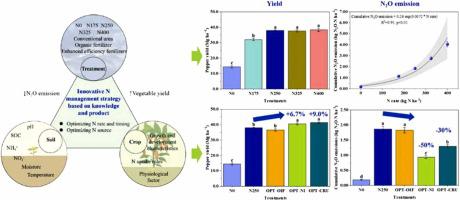Agriculture, Ecosystems & Environment ( IF 6.6 ) Pub Date : 2023-05-08 , DOI: 10.1016/j.agee.2023.108565 Fen Zhang , Xiao Ma , Xiaopeng Gao , Hailing Cao , Fabo Liu , Junjie Wang , Guangzheng Guo , Tao Liang , Yan Wang , Xinping Chen , Xiaozhong Wang

|
High N fertilizer inputs in subtropical vegetable systems under the warm and humid climatic conditions increase the risk of nitrous oxide (N2O) emissions. However, there is limited information available on integrated N management strategies to reduce N2O emissions from intensive open-field vegetable systems in subtropical region. Two plot-based field experiments were conducted in subtropical southwest China to examine the effects of different N management strategies on N2O emissions from a typical open-field pepper (Capsicum annuum L.) production system. Experiment 1 included five N rates (0, 175, 250, 325, and 400 kg ha−1) with conventional urea. Experiment 2 included a 0 N control and four N sources (conventional urea, organic fertilizer, nitrification inhibitor-based enhanced efficiency fertilizer ENTEC26, and controlled release urea) applied under an optimized N rate (250 kg N ha−1). The results of Experiment 1 showed that cumulative N2O emission and emission factor were 4.05 kg N ha−1 season−1 and 0.96%, respectively, under the conventional management (N400). N2O emissions increased exponentially with increasing N rates. Compared to the N400 treatment, application of conventional urea at the optimal rate (250 kg N ha−1) significantly reduced cumulative N2O emissions by 54% while maintaining similar pepper yield. The results from Experiment 2 indicated that the use of enhanced efficiency fertilizers at the optimal rate further reduced N2O emission by 30%− 50% compared to conventional urea, while increasing pepper yield by 6.7%− 9.0%. This resulted in a 36%− 53% reduction of yield-scaled N2O emission intensity. In particular, the use of nitrification inhibitor was 28% more effective than controlled release urea for N2O mitigation. These results suggest that the application of enhanced efficiency fertilizers at an optimum N rate could produce more vegetables while reducing N2O emission, thereby promoting sustainable vegetable production in the subtropic regions.



























 京公网安备 11010802027423号
京公网安备 11010802027423号